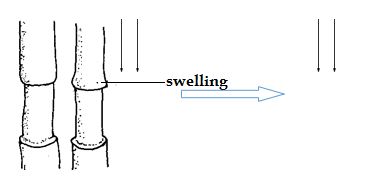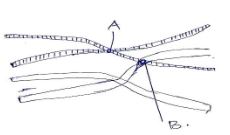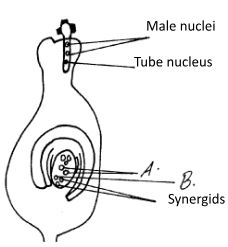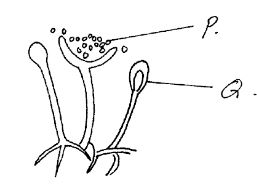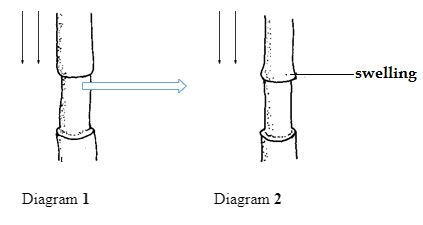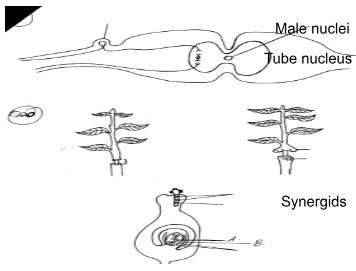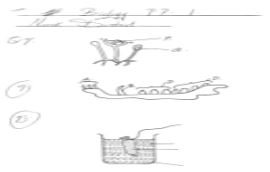QUESTIONS
- Name the mode of nutrition characterized by. (2 marks)
- A living organism feeding on another living host.
- Organisms living together in mutual benefit.
- What is meant by the term wilting? (2marks)
- Explain why it is important for some cells in the stomach wall to secrete mucus. (2marks)
- In estimating the population of elephants in one of the parks, their number was found to have greatly reduced. Give reasons why their number may have reduced. (3marks)
- What is the role played by the large pinna in elephants ? (2marks)
- The diagrams below represent an experiment that was set up to investigate a certain process in a plant stem.
Diagram 1 Diagram 2- Name the process that was being investigated. (1mark)
- Account for the swelling in diagram 2. (2marks)
- A student was found to have blood group B+
- What type of antibody is present in his plasma? (1mark)
- Which antigens are present in this blood group? (1mark)
- Plants relatively have less waste to excrete than animals. Give two reasons to explain this observation. (2marks)
- Homeostasis is defined as “the maintenance of a stable internal environment” in the body.
What is meant by expression “internal environment” ? (1 mark) - Name one factor that is maintained at a relatively constant level in the body by the following organs. (2marks)
- Liver.
- Kidneys.
- A constant supply of oxygen is necessary for plants to efficiently absorb dissolved mineral salts from the soil. Explain. (1mark)
- Name the feeding structures in parasiticfungi (i.e. the fungal structures that penetrate and draw nutrients from the host’s tissue). (1mark)
- Name the structure which prevents oxygenated and deoxygenated blood from mixing inside the mammalian heart. (1mark)
- Suggest means through which nutrients are made available in a lake. (2 marks)
-
- State two features of the placenta which speed up the exchange of materialsbetween the mother and the foetus. (2marks)
- Name the four hormones involved in regulation of the menstruation cycle. (4marks)
- To estimate the population size of mosquitoes in Banji village thatcovers an area of 25km2, visitingresearcherscaught 400 mosquitoes which they marked and released. After 24 hours, 200 mosquitoeswerecaught out of which 120 had not been marked.
- Suggest the samplingmethoddescribedabove. (1 mark)
- What are the disadvantages of thismethod ? (2 marks)
-
- What is eutrophication? (2 marks)
- What are the effects of eutrophication? (2 marks)
- Explain three ways in which the tracheaisadapted to perform its functions. (3marks)
- State two importances of classification of living organisms. (3marks)
- Give four differences between mitosis and meiosis. (4 marks)
- State three reasons why accumulation of lactic acid leads to an increase in heartbeat. (3marks)
- Name three mechanisms that ensure cross pollination takes place in flowering plants. (3 marks)
- The diagram below shows a phenomenon which occurs during cell division.
- Name the parts labeled A and B. (2marks)
- State the biological importance of the part labeled B. (1mark)
- Identify the type of all division in which this phenomenon occurs. (1mark)
- Name the organs in human being in which the phenomenon occurs. (2marks)
- Give three structural differences between wind and insect pollinated flowers. (3marks)
- Name three structures in a flower that wither off after fertilization. (3marks)
- The figure below shows some stage of development in the life of a plant.
- State the fate of A and B afterfertilization. (2marks)
- What name is given to this type of fertilization ? (1mark)
- Name two important functions of fruits to the life cycle of a plant.(2marks)
- Name the causative agent of the following infections. (3marks)
- Gonorrhoea.
- Syphilis.
- Trichomoniasis.
- Which part of the brain controls breathing in humans? (1mark)
- What is a membrane? (1mark)
- The diagram represents a bread mould growing on damp bread.
- Name the structure labeled P & Q. (2marks)
- Identify the kingdom to which it belongs. (1mark)
MARKING SCHEME
- Name the mode of nutrition characterized by. (2 marks.)
- A living organism feeding on another living host. Parasitism.
- Organisms living together in mutual benefit. Symbiosis.
- What is meant by the term wilting? (2marks)
- It is a phenomenon seen in plants on hot and dry days when the rate of water loss is more than that of absorption from the soil, causing turgor pressure in cell to reduce, hence cells shrink and the plant droops.
- Explain why it is important for some cells in the stomach wall to secrete mucus. (2marks)
- To prevent autolysis.
- In estimating the population of elephants in one of the parks, their number was found to have greatly reduced (3marks)
Give reasons why their number may have reduced- Poaching;
- Migration out of the park/ emigration rej. Immigration
- Death due to starvation
- Infected by the diseases
- What is the role played by the large pinna in elephants ? (2marks)
- Fanning/creating an air current for cooling effects.
- The diagrams below represent an experiment that was set up to investigate a certain process in a plant stem.
- Name the process that was being investigated (1mark)
- Translocation of (soluble) food (in phloem tissue); Accept: Transport of manufactured food (in phloem tissue); Reject: Transport in plants.
- Account for the swelling in diagram 2. (2marks)
- Ringing/ Ring-barking/ Girdling/ Cutting the bark off the plant stem from around the entire circumference removed phloem tissue; food accumulated in the region above the ring/ cut part; [Debarking: the process of removing bark from wood, for purposes e.g. of making fencing posts]
- Name the process that was being investigated (1mark)
- A student was found to have blood group B+
- What type of antibody is present in his plasma? (1mark)
- a
- Which antigens are present in this blood group? (1mark)
- Antigen B and Rhesus antigen/antigen D
- What type of antibody is present in his plasma? (1mark)
- Plants relatively have less waste to excrete than animals. Give two reasons to explain this observation. (2marks)
- Plants reuse some of their waste products
- Plants produce their waste products slowly compared to animals that produce slowly
- Homeostasis is defined as the maintenance of a stable internal environment in the body. What is meant by expression ‘internal environment’? (1 mark)
- Tissue fluid/ Intercellular fluid/ Interstitial fluid;] Acc. Surrounding of the body cells
- Name one factor that is maintained at a relatively constant level in the body by the following organs. (2marks)
- Liver Blood glucose (Reject: sugar) level;
- Kidneys Osmotic pressure/ Water content/ Osmolarity of body fluids (Accept: blood and tissue fluid) Accept: pH of body fluids (Accept: blood and tissue fluid); Reject: Osmoregulation
- A constant supply of oxygen is necessary for plants to efficiently absorb dissolved mineral salts from the soil. Explain. (1mark)
- Oxygen is used to oxidize glucose (in aerobic respiration); to yield energy (in form of adenosine triphosphate); for active uptake of mineral salts by plant roots; (Accept: for uptake of mineral salts against a concentration/ against a diffusion gradient).
- Name the feeding structures in parasitic fungi (i.e. the fungal structures that penetrate and draw nutrients from the host’s tissue). (1mark)
- Haustoria ; Reject: Haustorium- the singular.
- Name the structure which prevents oxygenated and deoxygenated blood from mixing inside the mammalian heart. (1mark)
- Septum ;
Acc. Interventricular/ Ventricular and interatrial and interauricular septum.
- Septum ;
- Suggest means through which nutrients are made available in a lake. (2 marks)
- Through decomposition of dead aquatic organisms (animals and plants)
- Silting/Surface runoff carrying the nutrients.
-
- State two features of the placenta which speed up the exchange of materials between the mother and the foetus. (2marks - Mark the first two answers).
- Chorionic villi are highly branched/ folded to offer large surface area (for exchange of material between maternal and foetal circulation);
- Chorionic villi are highly vascularized to maintain steep concentration gradient for materials between the foetal and maternal circulation;
- Chorionic villi have microvilli on their surfaces to further increase the surface area for exchange of material between maternal and foetal circulation;
Accept: The placenta is highly vascularized to maintain steep diffusion/ concentration gradient for faster exchange/ diffusion of material between maternal and foetal circulation.
- Name the four hormones involved in menstruation cycle. (4marks).
- Follicle stimulating hormone.
- Oestrogen hormone
- Luteinising hormone
- Progesterone hormone.
- State two features of the placenta which speed up the exchange of materials between the mother and the foetus. (2marks - Mark the first two answers).
- To estimate the population size of mosquitoes in Banji village that covers an area of 25km2, visiting researchers caught 400 mosquitoes which they marked and released. After 24 hours, 200 mosquitoes were caught out of which 120 had not been marked.
- Suggest the sampling method described above. (1 mark)
- Capture recapture method.
- What are the disadvantages of this method? (2 marks)
- Some organism may die during the study period.
- The mark may come the out during the study period.
- Suggest the sampling method described above. (1 mark)
-
- What is eutrophication? (2 marks)
- Breakdown of organic matter releasing excess nitrates and phosphates from sewage and fertilisers cause overgrowth of algae and bacteria in water body.
- What are the effects of eutrophication? (2 marks)
- Causes insufficient oxygen which causes the deaths of animals and plants in the water.
- What is eutrophication? (2 marks)
- Explain three ways in which the trachea is adapted to perform its functions. (3marks)
- Made up of rings of cartilage to ensure it does not collapse (or to keep it open always) during breathing. Also they enable the tubes to be stretched e.g. during coughing.
- Hollow tube to allow passage of air into the lungs.
- The incomplete rings (c-shaped) have gaps on the side facing the oesophagus which allow smooth swallowing.
- The inner lining of the trachea has mucus to trap and filter micro-organisms and dust particles preventing them from entering the lungs.
- The trachea is lined with cilia which beat in waves and move mucus and other foreign particles upwards into the pharynx.
- State two importances of classification of living organisms. (3marks)
- Enable identification of living organisms into their correct groups for reference.
- To understand the evolutionary relationship between different organisms.
- Give four differences between mitosis and meiosis (4 marks)
Mitosis Meiosis Two diploid daughter cells are formed Four haploid daughter cells are formed No crossing over There is crossing over hence chiasmata; formation Takes place in one cell division Takes place in two cell division Leads to growth Leads to gamete formation Takes place in somatic cells Takes place in reproductive cells - State three reasons why accumulation of lactic acid leads to an increase in heartbeat. (3marks)
- Speed up transport of lactic acid to the liver for oxidation (back into pyruvate).
- Speed up transport of oxygen to the liver, for oxidation of lactic acid.
- Speed up transport of the carbon (IV) oxide formed, from the liver to the lungs (for excretion).
- Name three mechanisms that ensure cross pollination takes place in flowering plants. (3marks)
- Protandry.
- Protogyny.
- Self-sterility or incompatibility.
- Heterostyly.
- The diagram below shows a phenomenon which occurs during cell division.
- Name the parts labeled A and B. (2marks)
- Centromere.
- Chiasma.
- State the biological importance of the part labeled B. (1mark)
- Leads to exchanging chromatid portions thus Important genetic changes usually result, causing hybrid vigour.
- Identify the type of all division in which this phenomenon occurs. (1mark)
- Meiosis.
- Name the organs in human being in which the phenomenon occurs. (2marks)
- Testis and ovaries.
- Name the parts labeled A and B. (2marks)
- Give three structural differences between wind and insect pollinated flowers. (3marks)
Wind Insect Large, brightly colored petal Small, dull petals Anthers are small and firmly attached Anthers are large and loosely attached Stigma small and sticky Stigma long and feathery - Name three structures in a flower that wither off after fertilization. (3marks)
- Anthers.
- Filaments.
- Style
- Stigma
- The figure below shows some stage of development in the life of a plant.
- State the fate of A and B after fertilization. (2marks)
- Forms the endosperm/ tripoid nuclei.
- Forms the embryo.
- What name is given to this type of fertilization? (1mark)
- Double fertilization.
- State the fate of A and B after fertilization. (2marks)
- Name two important functions of fruits to the life cycle of a plant (2marks)
- Nourish and protect the developing (Reject: germinating) seed(s) from mechanical damage.
- Bring about dispersal (Reject: dispersion) of seeds; Accept: Means through which seeds are dispersed; Reject: Metabolic waste collect in the fruit and are discharged out of the plant following abscission of fruits (this is a secondary function).
- Name the causative agent of the following infections. (3marks)
- Gonorrhoea – Bacterium Neiseeria Gonorrhoea.
- Syphilis – Bacterium Treponema Palladium.
- Trichomoniasis – Protozoan Trichomona Vaginalis.
- Which part of the brain controls breathing in humans? (1mark)
- Medulla oblongata.
- What is a membrane? (1mark)
- Surface structure which encloses the cell and organelle.
- The diagram represents a bread mould growing on damp bread.
- Name the structure labeled P & Q. (2marks)
- P - Spores.
- Q - Sporangium.
- Identify the kingdom to which it belongs. (1mark)
- Fungi.
- Name the structure labeled P & Q. (2marks)
Join our whatsapp group for latest updates
Tap Here to Download for 50/-
Get on WhatsApp for 50/-
Download Biology Paper 1 Questions and Answers - Form 3 Term 3 Opener Exams 2023.
Tap Here to Download for 50/-
Get on WhatsApp for 50/-
Why download?
- ✔ To read offline at any time.
- ✔ To Print at your convenience
- ✔ Share Easily with Friends / Students

